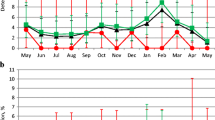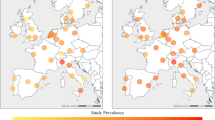Abstract
Coproscopic examination of 505 dogs originating from the western or central part of Switzerland revealed the presence (prevalence data) of the following helminthes: Toxocara canis (7.1%), hookworms (6.9%), Trichuris vulpis (5.5%), Toxascaris leonina (1.3%), Taeniidae (1.3%), Capillaria spp. (0.8%), and Diphyllobothrium latum (0.4%). Potential risk factors for infection were identified by a questionnaire: dogs from rural areas significantly more often had hookworms and taeniid eggs in their feces when compared to urban family dogs. Access to small rodents, offal, and carrion was identified as risk factor for hookworm and Taeniidae, while feeding of fresh and uncooked meat did not result in higher prevalences for these helminths. A group of 111 dogs was treated every 3 months with a combined medication of pyrantel embonate, praziquantel, and febantel, and fecal samples were collected for coproscopy in monthly intervals. Despite treatment, the yearly incidence of T. canis was 32%, while hookworms, T. vulpis, Capillaria spp., and Taeniidae reached incidences ranging from 11 to 22%. Fifty-seven percent of the 111 dogs had helminth eggs in their feces at least once during the 1-year study period. This finding implicates that an infection risk with potential zoonotic pathogens cannot be ruled out for the dog owner despite regular deworming four times a year.



Similar content being viewed by others
References
Barutzki D, Schaper R (2003) Endoparasites in dogs and cats in Germany 1999–2002. Parasitol Res 90 (Suppl 3):S148–S150
Deplazes P, Eckert J (2001) Veterinary aspects of alveolar echinococcosis—a zoonosis of public health significance. Vet Parasitol 98:65–87
Deplazes P, Guscetti F, Wunderlin E, Bucklar H, Skaggs J, Wolff K (1995) Endoparasite infection in stray and abandoned dogs in southern Switzerland. Schweiz Arch Tierheilkd 137:172–179
Deplazes P, Alther P, Tanner I, Thompson RC, Eckert J (1999) Echinococcus multilocularis coproantigen detection by enzyme-linked immunosorbent assay in fox, dog, and cat populations. J Parasitol 85:115–121
Eckert J (1997) Epidemiology of Echinococcus multilocularis and E. granulosus in central Europe. Parassitologia 39:337–344
Eckert J, Deplazes P (2004) Biological, epidemiological, and clinical aspects of echinococcosis, a zoonosis of increasing concern. Clin Microbiol Rev 17:107–135
Epe C, Coati N, Schnieder T (2004) Results of parasitological examinations of faecal samples from horses, ruminants, pigs, dogs, cats, hedgehogs and rabbits between 1998 and 2002. Dtsch Tierarztl Wochenschr 111:243–247
Gottstein B, Saucy F, Deplazes P, Reichen J, Demierre G, Busato A, Zuercher C, Pugin P (2001) Is high prevalence of Echinococcus multilocularis in wild and domestic animals associated with disease incidence in humans? Emerg Infect Dis 7:408–412
Glickman LT, Shofer FS (1987) Zoonotic visceral and ocular larva migrans. Vet Clin North Am Small Anim Pract 17:39–53
Jacquier P, Gottstein B, Stingelin Y, Eckert J (1991) Immunodiagnosis of toxocarosis in humans: evaluation of a new enzyme-linked immunosorbent assay kit. J Clin Microbiol 29:1831–1835
Lloyd S, Gemmell MA (1992) Efficacy of a drug combination of praziquantel, pyrantel embonate, and febantel against helminth infections in dogs. Am J Vet Res 53:2272–2273
Magnaval JF, Glickman LT, Dorchies P, Morassin B (2001) Highlights of human toxocariasis. Korean J Parasitol 39:1–11
Mathis A, Deplazes P, Eckert J (1996) An improved test system for PCR-based specific detection of Echinococcus multilocularis eggs. J Helminthol 70:219–222
Mehlhorn H, Hanser E, Harder A, Hansen O, Mencke N, Schaper R (2003) Synergistic effects of pyrantel and the febantel metabolite fenbendazole on adult Toxocara canis. Parasitol Res 90 (Suppl 3):S151–S153
Prelezov PN, Bauer C (2003) Comparative efficacy of flubendazole chewable tablets and a tablet combination of febantel, pyrantel embonate and praziquantel against Trichuris vulpis in experimentally infected dogs. Dtsch Tierarztl Wochenschr 110:419–421
Rommel M, Eckert J, Kutzer E, Körting W, Schnieder T (2000) Veterinärmedizinische Parasitologie, 5th edn. Blackwell, Berlin
Scothorn MW, Koutz FR, Groves HF (1965) Prenatal Toxocara canis infection in pups. J Am Vet Med Assoc 146:45–48
Sturchler D, Bruppacher R, Speiser F (1986) Epidemiological aspects of toxocariasis in Switzerland. Schweiz Med Wochenschr 116:1088–1093
Acknowledgements
We are grateful to U. Brönnimann and P. Stünzi for excellent technical assistance. Furthermore, the collection of samples from and the clinical examination of the dogs by the veterinarians is greatly acknowledged. We are also thankful to all the dog owners who were willing to participate in this study. This project was financed by the Swiss Federal Veterinary Office (BVET). Additional support was obtained from the EU project no. BBW 00.0498.
Author information
Authors and Affiliations
Corresponding author
Additional information
H. Sager and Ch. Steiner Moret contributed equally to the present work. This work is part of the doctoral thesis of Ch. Steiner Moret
Rights and permissions
About this article
Cite this article
Sager, H., Moret, C.S., Grimm, F. et al. Coprological study on intestinal helminths in Swiss dogs: temporal aspects of anthelminthic treatment. Parasitol Res 98, 333–338 (2006). https://doi.org/10.1007/s00436-005-0093-8
Received:
Accepted:
Published:
Issue Date:
DOI: https://doi.org/10.1007/s00436-005-0093-8




